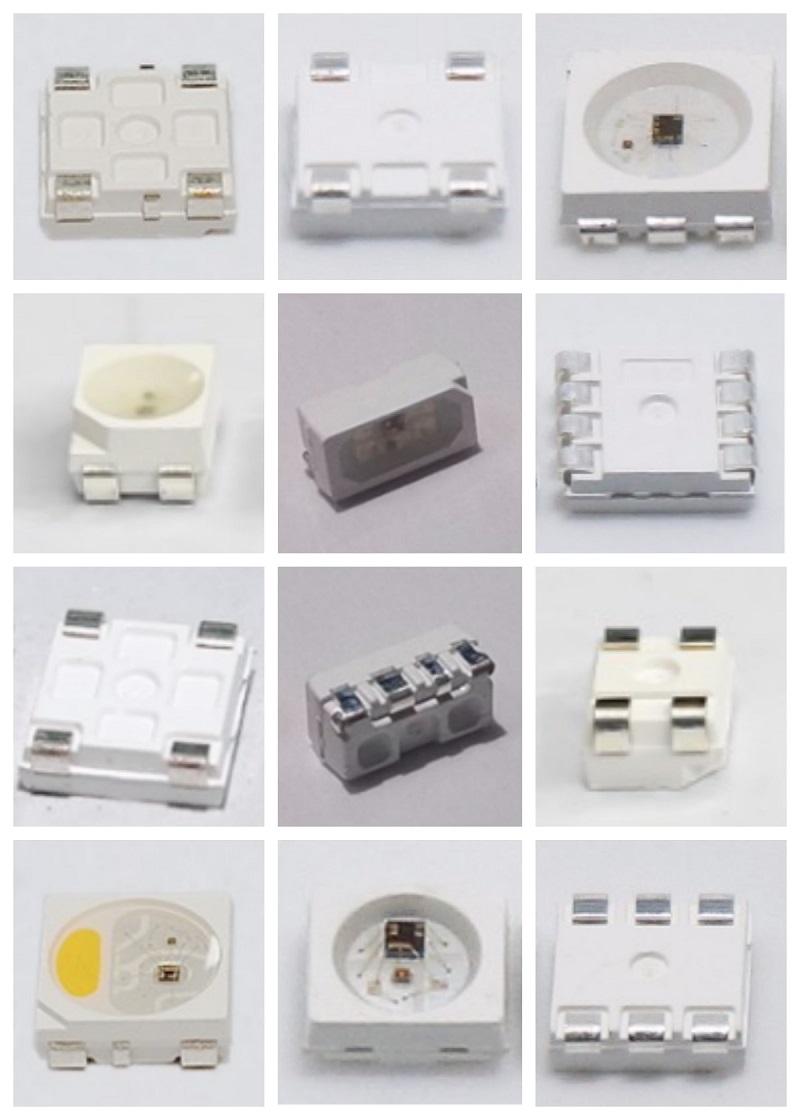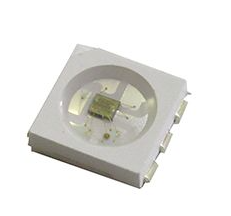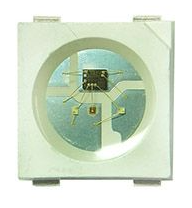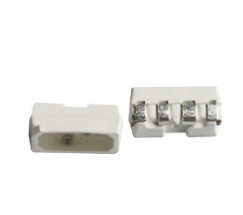
Table of Content
- 1. SMD LEDs with Integrated IC Definition
- 2. Types of SMD LED with Built-In IC
- 2.1 Classification According to Communication Protocol
- 2.2 Classification According to Color Capabilities
- 2.3 Classification by Size and form Factor:
- 2.4 Classification of Features by Application
- 2.5 Classification of Drive Current Specifications
- 2.6 Classification by Control Features
- 2.7 Directional Light Emission:
- 3. Technical Specifications of SMD LEDs with Built-in IC
- 4. SMD LED with Traditional Structure
- 5. SMD LED with IC Core Functions
- 6. SMD LED with Built-in IC Applications
- 7. Technical Advantages of SMD LEDs with Built-in IC
- 8. Manufacturers of SMD LEDs with ICs
- 9. FAQs on SMD LEDs with Built-in ICs
- 10. Summary
What type of LEDs do you first think of when discussing the LED industry? Let me tell you the answer. SMD LED with built-in IC. It is the basis of the optoelectronics sector, with a penetration rate that exceeds 75% in the consumer electronics, automotive, industrial displays and other areas. This is an incredible proportion!
1. SMD LEDs with Integrated IC Definition
Surface-mountable chips-sized SMD LEDs with Built-in IC are miniaturized optoelectronic devices that integrate a Light Emitting Diode with an integrated circuit. Surface Mount Technology (SMT), which allows the LEDs to be directly soldered on PCBs, creates a compact, trifunctional device that combines photonic emission, electronic drive, and intelligent controls in a single, unified structure.
2. Types of SMD LED with Built-In IC
2.1 Classification According to Communication Protocol
(1) Single Wire Addressable: uses a single dataline for control.
Example: WS2812 SMD led; WS2813 SMD led; WS2801Smd LED; WS2811Smd Led, etc.
(2) SPI: High speed communication with separate clock lines and data lines to ensure precise timing.
Examples: APA102, APA107, LPD8806
(3) I²C: Two-wire Protocol for Multi-Device Control on a Shared Bus.
Examples: PCA9685-driven modules
2.2 Classification According to Color Capabilities
(1) RGB: Red Green and Blue LEDs, each with its own control to mix colors.
Applications: Displays, decorative lighting
(2) RGBW: adds a white LED to improve color accuracy and light output.
Architectural Lighting
(3) Tunable White: Dual white LEDs allow for color temperature adjustment (e.g. 2700K-6500K).
Human-centric Lighting
(4) Single Color: Monochromatic LEDs (e.g. white, red, and blue) with brightness control.
Signage, indicators and other applications
2.3 Classification by Size and form Factor:
The following are the most common: 5050, 2835 (3535), 3528 (3528), 2427, 4020 (3512), 4246,4236,4242, 3725 (3725), EC3210R (2222), EC10, and so on.
As an example:
3528
Dimensions: 3.5 by 2.8 mm. Compact size and low power. Ideal for dense installations.
5050
Dimensions: 5 x 5 mm. Common in RGB strips.
CSP (Chip-Scale Package)
Dimensions: 1.0×1.0mm. Wearables and AR/VR displays.
2.4 Classification of Features by Application
(1) Automotive: AEC Q102 certified, wide temperature range from -40degC up to +125degC.
Use Cases: Interior lighting, headlights
(2) Industrial: High durability with IP67+ waterproofing and surge protection.
Use Cases: Machine vision, outdoor lighting
(3) Medical: Operation without flicker, high CRI >90 and low EMI.
Use Cases : Surgical Lighting, Diagnostics
(4) Decorative: Addressable Control, Dynamic Effects (e.g., Gradients, Chasing, etc.).
Use Cases: LED Strips, stage lighting
2.5 Classification of Drive Current Specifications
(1) Low-Current (5-20mA):
– Operating current: 5-20mA
– Voltage range: 3-5V DC
– Ultra low power consumption (<0.1W).
– Miniaturized CSP/COB packaging.
– Efficiency: >85% @ 5mA. Ideal for devices powered by batteries.
– Control: Single-wire Protocol or I²C.
Applications: Ideal in low-power scenarios that require strict energy efficiency. For example, small indicator lights and status LEDs on electronic devices (e.g. smart bracelets or remote controls).
Characteristics: Low luminous intensity, but sufficient to perform basic functions. Minimizes power consumption.
Industry Standard: IEC 6234 (low power efficiency)
(2) Mid-Current (50-150mA):
– Operating current: 50 to 150mA
– Voltage range: 12-24V DC
– Integrated PWM dimming (1-50kHz)
– Thermal resistance 5degC/W
– Efficiency: >90% at 12V input.
– Thermal Design: PCBs with aluminum cores and ceramic substrates.
Commonly used for general indoor and decorative illumination.
Characteristics: This category is the most widely used because it can balance brightness, energy consumption and luminous efficacy.
Industry Standard: EN 5515.1 (EMC Compliance)
(3) High-Current (200mA-1A):
– Operating current: 200mA-1A
– Voltage range: 24V to 48V DC
– Multi-chip
– Active Thermal Management (TJ Monitoring)
– Certifications AEC-Q102 automotive, UL-8750 high-power LEDs.
– Driver Integration: Built-in buck/boost converters.
Applications: Automotive headlights and high-brightness applications.
Characteristics: The high current can generate significant heat, requiring robust thermal management to ensure reliable operation and long-term durability.
Industry Standard: AEC Q102 (Automotive), IEC 600601-2-41
2.6 Classification by Control Features
(1) Addressable: Individual LED control via data protocols (e.g., WS2812B).
Example: LED matrices and art installations.
(2) Non Addressable: Group Control with PWM Dimming, Simpler Circuitry.
Example: Basic indicators and backlighting.
(3) SmartLEDs: IoT enabled with Wi-Fi/Bluetooth integration and apps (e.g. Philips Hue).
Example: Smart home lighting
2.7 Directional Light Emission:
(1) Front Emission:
The lamp beads have their front sides mounted on the PCB. Light isemitted perpendicularly to the PCB ensuring a viewing angle all around of about 140deg-160deg.
(2) Side Emission:
The PCB is mounted on one side of the lamp beads, and the light is emitted in a parallel direction to the PCB. The light is then redirected by components such as a light guide. These screens have a higher transmittance because the circuit board prevents part of the light from reaching the screen, which ensures only one viewing angle.
3. Technical Specifications of SMD LEDs with Built-in IC
(1) High Integrity
Reduces PCB footprint over 60% by eliminating peripheral driver circuits that are required for conventional LEDs.
Supports CSP or COB packaging with dimensions as small as 1.0×0.5mm (0404 form factor).
(2) Intelligent Control
The integrated IC allows:
Digital protocol control (I2C, Single-wire Interface, SPI)
Analog dimming( 0-10V linear regulation).
Functionalities that are advanced:
16-bit grayscale control (65,536 levels).
Dynamic lighting effects: breathing, gradient, strobe.
Temperature compensation in real-time.
(3) Energy Efficiency and Reliability
Protection mechanisms embedded in the device:
The (OVP/OCP/OTP ) safeguards are used.
The MTBF (Mean time between failures) of the product is greater than 50,000 hours.
Energy efficiency >90%. A 15-20% improvement compared to conventional solutions.
(4) Communication & Scalability
The Cascading Control Architecture allows for the single-bus control of hundreds of LEDs.
IoT protocol compatibility for intelligent lighting systems (DALI and Zigbee).
4. SMD LED with Traditional Structure
(1) Light-Emitting Layer:
LED Chip: GaN based blue LED (450nm wavelength), combined with YAG phosphor to emit white light (CCT range of 2700K-6500K).
Luminous Efficacy : up to 180 lm/W @350mA drive, CCT4000K, according to IES LM80 testing protocol.
(2) Control Layer:
Driver ICs integrating critical circuits
Constant current source (+-1% accuracy, JEDEC JESD22-A101 qualified)
PWM dimming module (1kHz-50kHz frequency range, IEEE 1789 compliant)
Communication protocol decoder (I2C/SPI/single-wire interface, IEC 61131-2 standard) etc.
Protection Circuitry:
Triple-safeguard architecture:
Overvoltage Protection (OVP, 40V clamp voltage)
Overcurrent Protection (OCP): +-5% of current threshold.
Thermal Shutdown (TSD) trigger point is 150degC.
(3) Package Structure:
Substrate Materials:
High-Temperature Cofired Ceramic (CTE 6.5 ppm/degC).
High-thermal-conductivity epoxy resin (>2.5 W/m*K, UL 94 V-0 flame-rated).
Optical Design
The integrated micro-lens (MLA) includes:
Beam angle: 120deg +-10% (IESNA LM-79 angular distribution)
Light uniformity: >90% CIE 015:2018 spatial homogeneity criteria.
5. SMD LED with IC Core Functions
(1) External Driver-Free Operation:
Built-in constant current ICs directly match 3-5V supply voltage, eliminating the need for external driver circuits.
(2) Dynamic Lighting Effects:
RGB color-mixing ICs can support up to 16.7 million colours with a response time of 1 ms.
(3) Environment Adaptability:
Automatic brightness adjustment is possible with integrated light sensors.
(4) High-Density Displays:
The ultra-compact driver ICs allow for pixel pitches of P0.4.
6. SMD LED with Built-in IC Applications
(1) It is widely used by Consumer Electronics, such as flash in smart phones and wearable devices.
(2) It’s commonly used in Automotive Lighting such as Matrix Headlights and Cockpit Atmosphere Lights.
(3) It’s a common feature in Industrial Displays such as Mini Led Backlight.
(4) It can also be used in IoT, Smart Cities and smart street lighting.
7. Technical Advantages of SMD LEDs with Built-in IC
(1) Circuit Complexity:
The SMD LED with built-in IC eliminates external components by direct surface mounting. (IPC-2221A-compliant). Its BOM costs have been reduced by 45%. Conventional LED solutions use external driver circuits such as buck converters and current-limiting resistances that occupy >30% PCB space. This is a 68% decrease in board area utilization compared to discrete LED implementations.
(2) Control Precision:
The SMD LED with built-in IC has a digital dimming precision of +-0.5% (16 bit resolution), while the conventional LED has an analog dimming of +-10%.
(3) Production Yield:
The SMD LED with Integrated IC uses fully automated Surface Mount Technology (SMT) processes. This technology achieves component mounting precisions of +0.025mm, and throughput rates in excess of 80,000 CPH.
The majority of conventional LED products are manufactured by automated reflow-soldering processes. Production yields for these products is approximately 92%. (IPC A-610 Class 2, compliant). This is due to inherent limitations with component alignment accuracy (within a tolerance of +-0.1mm) and thermal profiles (J-STD 020 temperature profile adhesion with a +-5degC range).
SMD LEDs with built-in ICs are packaged fully automatically, and have a failure rate as low as 50ppm compared to the 300-500ppm of conventional LED assembly.
(4) Response Speed:
The SMD LED with built-in IC delivers dimming response time 100ns, as tested by JESD22A114. Conventional LEDs are constrained by an external driver latency of 10ms due to signal conversion delay and PCB trace parasitic effect (per IPC-2223 guidelines on signal integrity).
(5) Reliability:
The SMD LED with built-in IC has a MTBF of over 100,000 hours, which is AEC-Q102 certified for automotive headlamps. Conventional LEDs have a MTBF of 50,000 hours due to the intermetallic compound growth (IMC) at solder interfaces as well as polymer insulation degradation.
(6) Development Cycle:
The development cycle for SMD LEDs with built-in ICs is shorter. The software configuration of SMD LEDs with Built-in IC can be completed in 1-2 days.
8. Manufacturers of SMD LEDs with ICs
The world is full of SMD LEDs with (Built in) IC manufacturers. This list represents the largest number of manufacturers.
Seoul Semiconductor
OSRAM
Nichia
Lumileds
Samsung LED
Worldsemi
Sanan Optoelectronics
HC SemiTek
Jufei Optoelectronics
BOE
…
9. FAQs on SMD LEDs with Built-in ICs
10. Summary
The SMD LED with Integrated IC, by achieving SiP integration at the chip-level, realizes a closed-loop, fully-functional system (power supply, driving and intelligent control) in a 1mm3 footprint. It is a cornerstone for miniaturized intelligent optoelectronic devices and will continue to penetrate cutting-edge areas like AR/VR, biomedical devices and more.






